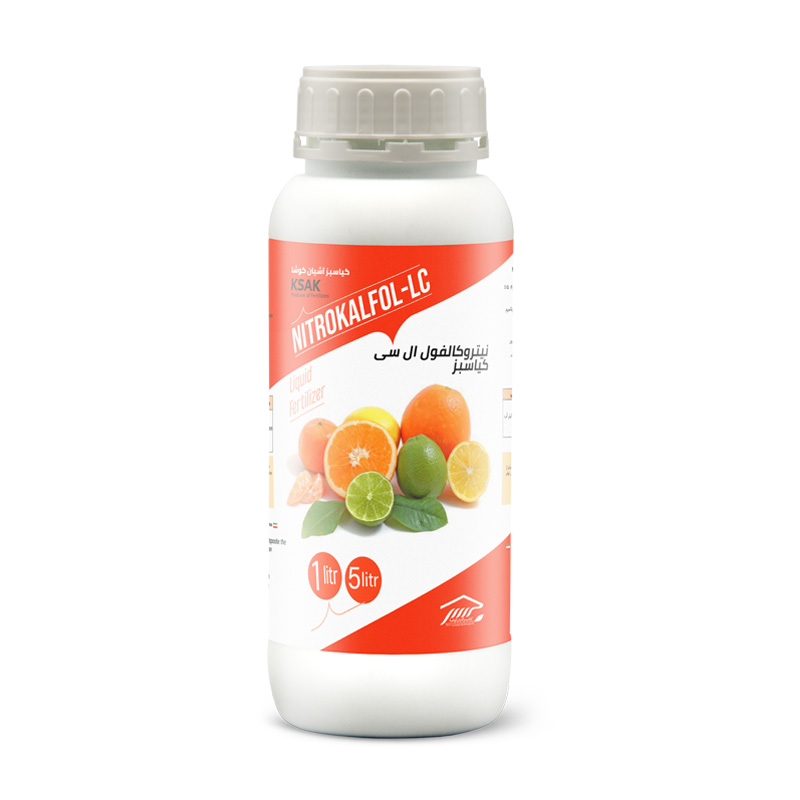
1400/11/29
Nitrokalfol - LC
NPK ( 8 - 5 - 15 ) +TE
Nitrocalfol-LC liquid fertilizer has a high percentage of micronutrients and creates a balanced state in citrus nutrition. The use of this fertilizer increases the yield, quality and increases the resistance of citrus against many physiological diseases and increases their resistance to pests and diseases. These products have no risk of salinization in the soil due to their chlorine-free nature and the type of materials used in the formulation. (LOW EC) For heavy metals, it has a controlled analysis according to the standard.
Nitrocalfeol - LC liquid fertilizer compounds:
Elements |
W/W |
W/V |
| Total nitrogen | 8% | 10% |
| Absorbable phosphorus | 5% | 6.3% |
| Absorbable potassium | 15% | 19% |
Tips about citrus:
Citrus is a shrubby plant, a shrub with dense foliage or a tree with purple flowers. The flowers have 8-4 thick white, red or purple petals, 5-4 sepals and 32-36 flags. Citrus is one of the most important tropical and subtropical fruits in the world. They are very sensitive to wind and grow best in well-drained, well-drained soil. Also, the groundwater level should be lower than 2 meters. Because citrus roots need a lot of oxygen, on the other hand, the soil should be such that it can hold rainwater and irrigation well for a while. In general, medium lemon soil is good for citrus, but from heavy soils or soils. Sand should be avoided. The best soil pH for our citrus is between 6 and 5.5, but in most places where citrus is planted, the soil is alkaline. Citrus fruits are sensitive to soil salinity. Flowering time in citrus is strongly influenced by environmental factors, especially temperature and soil moisture. Flowering usually begins with the cessation or reduction of vegetative growth. Most citrus species in subtropical regions with cold winters only prune once a year and in early spring. In these areas, flowering takes place in mid-December. Flowers appear in axial buds on vegetative branches formed this year (both spring and summer growth in late July to September). Therefore, flower buds occur in 12-month-old buds (from spring growth) or 6-5 months (from summer growth). Oranges, grapefruits and tangerine hybrids follow this pattern. In citrus, the amount of fruiting has a more decisive role than the amount of flowering in the final yield. Nutrients are directly and indirectly related to the flowering of citrus trees.
Properties of suggested fertilizer for citrus:
1-The fertilizer has a high concentration of micronutrients and creates a balance situation in citrus trees nutrition
2- increase the yield, quality and resistance of citrus against physiological diseases and pests.
3- Prevents thickening of the skin because it has sufficient zinc
4-this fertilizer have enough Magnesium Thus it Prevent deficiency of Magnesium
5-The product doesn’t have a salinity risk because it’s free-chlorine property and the used materials at its formulation (low EC).
6- Concentration of heavy metals at the product is in accordance with the standard levels.
|
Product Name |
Growth period |
Foliar spray |
|
Citrus |
1- During the buds swelling (before the flowering) |
2-4 kg per 1000 liters water |
|
2- 15 days after flower falling |
2-4 kg per 1000 liters water |
|
|
3- 20 days after the second stage |
2-4 kg per 1000 liters water |
توجه :
محلول پاشی برگها باید در خنک ترین ساعات روز انجام شود. قبل از اختلاط با سایر سموم و کودها jar test انجام شود و پس از اطمینان از سازگاری فیزیکی در سطح کمی از مزرعه آزمایش و در صورت مثبت بودن اختلاط میتوان آنرا در سطح وسیع بکار برد.

